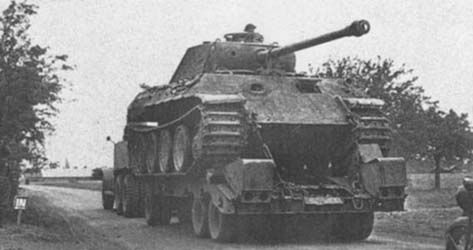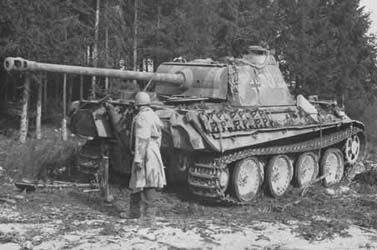/Vehicles/Axis/Germany/02-mPanzers/PzKpfw5-Panther/File/6-inAction.htm | Last Up-date: 27-02-2011
Panzerkampfwagen V Panther Medium Tank
in Action
Le moteur du Panther Ausf.A/D1, le HL 210, étant insuffisant on installa sur la Panther Ausf.D/D2, le HL 230, plus puissant. Cependant cette modification n'était pas suffisante car le HL 230 avait tendance à chauffer et à prendre feu. En fait c'était tout le système de propulsion qui était fragilisé par les 45 tonnes du Panther. Le caoutchouc des galets étaient de plus mis à rude épreuve et devait être remplacé très souvent donc perte de temps. Malgré ces défauts le Panther selon les désirs d'Hitler fut lancé très tôt sans être véritablement au point, lors de l'opération Zitadelle, sur Koursk en juillet 1943 (l'opération prévue au printemps avait été reportée spécialement pour la mise en oeuvre de nouveaux matériel comme le Panther et l'Elefant). Bien entendu ce ne fut guère brillant, sur les 200 Panthers de la IVe Panzer.Armee du Hoth, 160 furent mis hors de combat dès le premier soir et perdus au profit des Russes ! Seul 43 Panthers éteint encore aux mains des Allemands, le jour suivant !
The HL 210 engine originally fitted to the Panther Ausf.A/D1 prototype was not powerful enough, and so the more powerful HL 230 engine was fitted on the Panther Ausf.D/D2 production model. However this modification raised problems in turn, because the HL 230 tended to overheat and catch fire. In truth, the 45 tons weight of the Panther caused problems for much of the power chain and transmission. The rubber rims of the road wheels were under continual stress, and had to be replaced frequently, which was time consuming. In spite of these defects being known and not yet rectified, Hitler insisted that the Panther be launched into combat in the Zitadelle operation at Kursk in July 1943. (Originally planned for the Spring, the attack had been deferred in order to include the new Panther and Elefant vehicles.). The result was a disaster: of the 200 Panthers in Hoth’s IVth Panzer army, 160 were out of action by the first evening and lost to the Russians! Only 43 Panthers remained in German hands the following day. Most of the tanks lost had broken down; mechanical defects caused more damage than the Soviet anti-tank weapons.
 |
 |
| Char Panther Ausf.G abandonné dans les Ardennes belges. | Panther Ausf.A de la Panzer-Lehr abandonné dans un fossé près de Dézert au nord de Saint-Lô après l'attaque alliée du 11 juillet 1944 contre le canal Vire-Taute. |
Panther Ausf.G abandonned
in the Belgian Ardennes.
|
Panther Ausf.A of the
Panzer-Lehr abandoned in a ditch close to Dézert to the north
of Saint-Lô after the allied attack of July 11 1944 against
the canal Vire-Taute. |
src: Site "Juggernauts
of the second world war"
|
src: Normandie 44, Album Mémorial, Ed.Heimdal
|
La plupart étaient tout simplement tombés en panne ! Les défauts mécaniques causèrent plus de dégats que les armes anti-chars soviétiques. Les Panthers Ausf.D qui participèrent à cette bataille servirent dans les Panzer Abteilungen 51 et 52 (2 x 96), dans le Panzer Regiment Stab 39 (2 x 18) et dans diverses unités du Heeregruppe Sud. Par la suite les autres Panthers du modèle D et des modèles ultérieurs servirent dans des bataillons indépendents au sein des Panzer.Divisions et également dans les Pz.Rgt des SS-Pz.Divsions Das Reich et LSSAH. Cependant seulles les unités d'élite purent disposer d'effectifs complets. La production ne rencontra jamais le demande, de sorte que le Panther ne put jamais remplacer véritablement le Panzer IV.
The majority had quite simply broken down! The mechanical defects caused more damage than the Soviet anti-tank weapons. Panthers Ausf.D which took part in this battle were useful in Panzer Abteilungen 51 and 52 (2 X 96), in Panzer Regiment Stab 39 (2 X 18) and in various units of Heeregruppe South. Thereafter other Panthers of the model D and the later models were used in independent battalions within Panzer.Divisions and also in Pz.Rgt of SS-Pz.Divsions Das Reich and LSSAH. However only the elit units could laid out of complete strenghts. The production never met requires, so that the Panther could never replace truly Panzer IV.
 |
 |
Ersatz M10 abandonné dans les Ardennes. |
Panther Ausf.D sur le front est. |
Ersatz M10 abandonned
in the Ardennes
|
Panther Ausf.D on the
Russian front |
src: Site "Juggernauts
of the second world war"
|
src: Site "German's
Vehicle History" |
 |
 |
Befehlspanther Ausf.A mis hors de combat lors
de la retraite allemande vers la Seine. |
Panther du 2e SS-Panzerkorps rapatrié
par train de Galicie (vers Ternopol), le 12 juin 1944 en direction
de la Normandie. |
Befehlspanther Ausf.A
put outside fight during the German retirement towards the Seine.
|
Panther of the 2nd SS-Panzerkorps
repatriated by train from Galicia (towards Ternopol), June 12 1944
to go in Normandy. |
src: Normandie 44, Album Mémorial, Ed.Heimdal
|
src: Normandie 44, Album Mémorial, Ed.Heimdal |
 |
 |
Panther Ausf.A capturé intact par les
Britanniques le 7 juillet 1944, dans la région de Caen est
déplacé sur un T19 Tank Transporter. |
Panthers d'une unité de la Panzer-Lehr
en colonne pour une inspection en Hongrie en mars 1944. |
Panther Ausf.A captured
intact by the Britisher July 7 1944, in the region of Caen is moved
on a T19 Tank Transporter. |
Panthers of a unit of
the Panzer-Lehr in column for an inspection in Hungary in March
1944. |
src: Normandie 44, Album Mémorial, Ed.Heimdal
|
src: Normandie 44, Album Mémorial, Ed.Heimdal |
 |
 |
Panthers abandonnés dans
les Ardennes dans les régions de Rochefort et de Celles. |
|
Panthers abandonned
in the Ardennes in the Rochefort and Celles areas. |
|
| Panther Abteilung (1943) |
|
| They are ideal strenghts, sometimes far from the reality of the front! |
 |
 |
Panther Ausf.G abandonné durant l'offensive
des Ardennes. |
Panther Ausf.D hors de combat sur le front russe. |
Panther Ausf.G abandonned
during the offensive of the Ardennes. |
Panther Ausf.D knocked
out on the Russian front. |
src: Pz.Kpfw V in action, Armor Number 11 (squadron/signal
publications, inc.)
|
src: Site
"Panzerwaffe" |
 |
 |
Panthers abandonnés
dans les Ardennes. |
|
Panthers abandonned
in the Ardennes.
|
|
A partir du modèle A, le Panther devint une arme formidable et le meilleur char allemand de la deuxième guerre mondiale. Il fut abondamment utilisé en Normandie où 400 d'entre-eux furent détruits. En général les Panthers endommagés retournaient à l'usine pour réparations où pour être reconvertis en véhicules hybrides.
Starting with the first production model A, the Panther was a formidable weapon and the best German tank of the second world war. Many were used in Normandy, where some 400 were destroyed. In general, damaged Panthers were returned to the factory for repairs or for conversion into hybrid vehicles.
 |
 |
Tankistes britanniques examinant un Panther
Ausf.A abandonné quelque part en Normandie. |
Tankistes faisant leur toilette sur les plate-formes. |
British Tankists examining
a Panther Ausf.A abandoned somewhere in Normandy. |
Tankists doing their
toilet on the platforms. |
src: Les Panzers (Normandie 44), Ed. Heimdal
|
|
 |
 |
Befehlspanther V victime d'un bazooka de la
101e Airborne dans le village hollandais de Erp, le 23 septembre
1944. |
Carcasse de Panther Ausf.G avec suspension
dotée de galets tout en acier. |
Befehlspanther V victim
of a bazooka of the 101st Airborne in the Dutch village of Erp,
September 23 1944. |
Carcass of Panther Ausf.G
with steel-wheeled suspension |
src: Tank Illustrated n°9
|
|
Notons une utilisation très étrange du Panther: lors de la bataille des Ardennes, quelques Panthers furent camouflés en M10 américain (Tank destroyer) par ajout de feuilles de métal. Ces engins servirent dans la Panzer Brigade 150 d'Otto Skorzeny chargée de créer le désordre dans les lignes ennemies. Ces engins connurent peur de succès en raison des réactions qu'il suscitèrent auprès de leurs propres troupes !
We should note one unusual modification of the Panther: at the time of the battle of the Ardennes, some Panther tanks were camouflaged to look like American M10 tank destroyers, by the addition of metal sheets. These machines were used by the Panzer Brigade 150 of Otto Skorzeny, as part of a plan to create disorder in the American rear lines. That this ruse was successful, can be judged by the fact that these vehicles apparently caused consternation among some of the German troops.
 |
 |
Panther en maintenance |
Panther Ausf.G (fin de production), abandonné
à La Gleize, durant la bataille des Ardennes. |
Panther in maintenance
|
Ausf.G Panther (late
production), abandoned in La Gleize, during the battle of the Ardennes. |
src: Site Panzer
Page von Reitsch
|
 |
Enlèvement du moteur d'un Panther Ausf.D. |
Removal of the engine of a Panther Ausf.D. |
src: Site Panzer
Page von Reitsch |
 |
Panther en panne, remorqué par trois
tracteurs FAMO (Sd.Kfz.9). |
Broken down Panther,
towed by three tractors FAMO (Sd.Kfz.9). |
src: Site Panzer
Page von Reitsch |
Sources:
- Pz.Kpfw V in action, Armor Number 11 (squadron/signal publications, inc.)
- Connaissance de l'Histoire (Hachette) - N°17 - " Les chars de combat allemands 39-45"
- Connaissance de l'Histoire (Hachette) - N°5 - " Véhicules blindés allemands 39-45"
- Les Blindés de la Seconde Guerre Mondiale (Atlas)
- Panther Medium Tank 1942-1945 (Osprey Military) - New Vanguard N°67
- Panther Variants 1942-1945 (Osprey Military) - New Vanguard N°22
- Site "Achtung Panzer" - http://www.achtungpanzer.com
- Site "Germany's vehicle history" - http://www.wwiivehicles.com/html/germany/index.htm
- Site "Second World War Armour" - http://www.onwar.com/tanks/index.htm